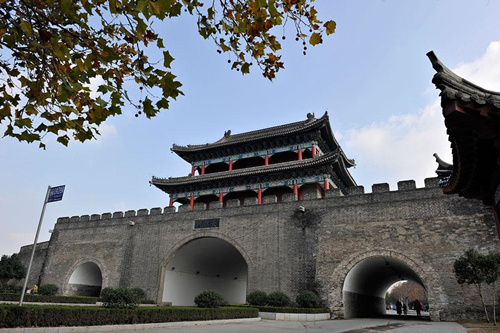Transportation made ancient Kaifeng ideal for capital
Author : ZHANG QINGLI, ZHANG JIE Source : Chinese Social Sciences Today 2017-08-29

Daliang Gate, the western gate of the ancient Kaifeng city
Throughout Chinese history, rulers have considered various factors when choosing a city to be their capital. In general, there were three factors for consideration, said Li Quan, director of the Grand Canal Research Institute at Liaocheng University. The first was whether the city had natural barriers to prevent invaders; the second was whether it was at an economic center to fulfill the daily needs of people in the city; and the third is whether it was located at the center of the country so that government orders could be sent out in every direction.
It was hard for a city to meet all the three conditions. Nevertheless, “the transportation convenience can make up for other deficiencies,” Li said. Even without natural barriers or economic advantages, a city can dispatch troops as well as goods and materials from elsewhere easily relying on well-developed transportation. Also, transportation convenience can make it easier for a city to connect with other regions, especially politically.
Li said that in ancient times, the cost of land transportation was high and conditions were frequently unstable, while water transportation was more economical, convenient and stable. Meanwhile, sea transportation was riskier so inland waterways became the main means of water transportation. Since the Sui and Tang dynasties, the decision of whether or not to connect to the Grand Canal became a major parameter for choosing the capital. Without exception, the Song, Yuan, Ming, and Qing dynasties all made their capitals along the route of the Grand Canal.
To strengthen the connection between the north and south of China, the Sui Dynasty constructed the Grand Canal around Luoyang, Henan Province. “In the Tang Dynasty, the role of the Grand Canal became prominent. It not only related to the national destiny but also directly influenced the choice of the capital city,” said Professor Cao Jiaqi from Sun Yat-sen University. In the Tang Dynasty, with the population in the capital Chang’an, surrounding areas grew, material supplies were increasingly dependent on taxes from provinces in southern and eastern China, while Luoyang, as the heart of the Grand Canal, became the new capital, or the “Eastern Capital” of the dynasty.
Nevertheless, during the later stages of the Tang Dynasty, Luoyang was greatly damaged by political turmoil and warfare, and the role of the waterway around the city also declined. Then Kaifeng, as the hub of land and water transportation, became a favored place for the capital during the following several dynasties, like the Later Liang, Later Jin, Later Han, Later Zhou and Northern Song dynasties, Cao said.
Among all Chinese ancient capitals, Kaifeng had the most developed and convenient water transportation network. Situated between the Yellow River and the Huaihe River, Kaifeng was at the center of the canal system in Northern Song Dynasty which connected the Huaihe River and Xingou Ditch in the south as well as the Yellow River, Jishui River and Weihe River in the North. “Canals and ditches in the water transportation network were the means for transporting official tributes and taxes as well as the route for traveling merchants from home and abroad,” Cao said.
In addition, Kaifeng also had advanced land transportation. Li said that after the Shang and Zhou dynasties, a vital land transportation route was formed. Passing the Hangu Pass in Sanmenxia City in Henan, one could go east along the Yellow River to Luoyang, Kaifeng in Henan and then to Linzi in Zibo, Shandong Province. Also, going north from Hangu Pass and crossing the Yellow River, one can reach the area where today’s Beijing situated; going south, there were also roads connecting southeastern and southern regions. Therefore, centered in Kaifeng, the land transportation network could reach all parts of the country and all surrounding states.
Ye Shengtao made Chinese fairy tales from a wilderness
Ye Shengtao (1894–1988) created the first collection of fairy tales in the history of Chinese children’s literature...
-
How northern ethnicities integrated into Chinese nation
2023-09-18
-
Mogao caves
2023-09-12
-
Mogao Grottoes as ‘a place of pilgrimage’
2023-09-12
-
Time-honored architectural traditions in China
2023-08-29
-
Disentangling the civilizational evolution of China
2023-08-28
-
AI ethics in science fiction
2023-08-23














 2011-2013 by www.cssn.cn. All Rights Reserved
2011-2013 by www.cssn.cn. All Rights Reserved